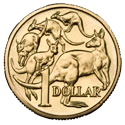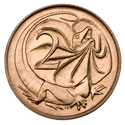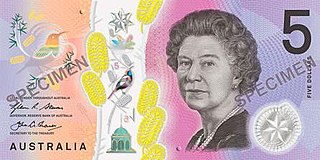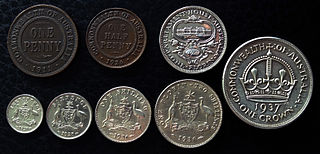
The Australian dollar is the currency of Australia, and of three independent Pacific Island states, specifically Kiribati, Nauru, and Tuvalu. It was introduced on 14 February 1966 when the pre-decimal Australian pound, with subunits of shillings and pence, was replaced by the new decimal currency, the Australian dollar.

The Australian pound was the currency of Australia from 1910 until 14 February 1966, when it was replaced by the Australian dollar. As with other £sd currencies, it was subdivided into 20 shillings, each of 12 pence.
The pound was the currency of New Zealand from 1840 until 1967, when it was replaced by the New Zealand dollar.

The Australian one dollar coin is the second-most-valuable circulation denomination coin of the Australian dollar after the two-dollar coin; there are also non-circulating legal-tender coins of higher denominations.
The Australian fifty-dollar note is an Australian banknote with a face value of fifty Australian dollars (A$50). It is currently a polymer banknote, featuring portraits of David Unaipon and Edith Cowan.

The Australian twenty-dollar note was issued when the currency was changed from the Australian pound to the Australian dollar on 14 February 1966. It replaced the £10 note which had similar orange colouration. There have been only two different issues of this denomination: a paper note which had a gradient of yellow and red, with a distinct orange background, and a polymer note which can be recognised for its distinct red-orange colouration. The polymer note was issued on 31 October 1994.

The Australian ten-dollar note was issued when the currency was changed from the Australian pound to the Australian dollar on 14 February 1966; it replaced the £5 note which had similar blue colouration. There have been four different issues of this denomination, a paper banknote, a commemorative hipolymer note to celebrate the bicentennial of Australian settlement, the 1993-2017 polymer note, and from September 2017 a polymer note featuring a transparent window.

The Australian one hundred-dollar note was first issued in 1984 as a paper note. There have been two different issues of this denomination: initially a very light turquoise-blue paper note, and from May 1996, a green polymer note.

The Australian two-cent coin was introduced in 1966 and was the coin of the second-lowest denomination until it was withdrawn from circulation in 1992. It is still counted as legal tender, but is subject to some restrictions, and one-cent and two-cent coins are legal tender only up to the sum of 20 cents.

The Australian one-dollar note was introduced in 1966 due to decimalisation, to replace the 10-shilling note. The note was issued from its introduction in 1966 until its replacement by the one-dollar coin in 1984. Approximately 1.7 billion one-dollar notes were printed.

The Australian two-dollar note was introduced in 1966 due to decimalisation, to replace the £1 note which had similar green colouration. The note was issued from its introduction in 1966 until its replacement by the two dollar coin in 1988.

The 10/- banknote was first issued on 1 May 1913 as a blue banknote payable in gold. It was equal to a half sovereign gold coin. The sizes varied but the design was the same for the following issues: 1913–1914 issue was 194×83mm, 1915–1923 197×88 mm, 1923–1933 180×78mm. This issue was payable in gold but subsequent issues were legal tender.

The Australian five-dollar note was first issued on 29 May 1967, fifteen months after the currency was changed from the Australian pound to the Australian dollar on 14 February 1966. It was a new denomination with mauve colouration – the pound system had no £2½ note.

The round fifty cent coin was the highest-denomination and largest diameter coin of the Australian dollar's decimal coins, introduced in 1966. Due to large amounts made in 1966 and the rising cost of silver, it was not made in any other year. It was replaced by a dodecagonal 50 cent coin in 1969, which retained its reverse of the Australian Coat of Arms.

Federation in 1901 gave the Commonwealth a constitutional power to issue coins and removed this power from the States. However, British coins continued in use until 1910, when Australian silver coins were introduced. These included florins, shillings, sixpences and threepences. They had a portrait of King Edward VII on one side. Australian pennies and half-pennies were introduced into circulation the following year. In 1931 gold sovereigns stopped being minted in Australia. A crown or five-shilling coin was minted in 1937 and 1938.
Coins of the Australian dollar were introduced on 14 February 1966, although they did not at that time include one-dollar or two-dollar coins. The dollar was equivalent in value to 10 shillings in the former currency.
The Australian florin was a coin used in the Commonwealth of Australia before decimalisation in 1966. The denomination was first minted in 1910 to the same size and weight as the United Kingdom florin.
The banknotes of the Australian dollar were first issued by the Reserve Bank of Australia on 14 February 1966, when Australia adopted decimal currency. This currency was a lot easier for calculating cost rather than the British, Pound, Shilling and Pence system. The $5 note was not issued until May 1967.

The Australian one-pound note was the most prevalent bankote in circulation with the pound series, with the last series of 1953–66 having 1,066 million banknotes printed. The first banknotes issued were superscribed notes purchased from 15 banks across Australia and printed with Australian Note and were payable in gold.

Banknotes of the Australian pound were first issued by numerous private banks in Australia, starting with the Bank of New South Wales in 1817. Acceptance of private bank notes was not made compulsory by legal tender laws but they were widely used and accepted. The Queensland government issued treasury notes (1866–1869) and banknotes (1893–1910), which were legal tender in Queensland. The New South Wales government issued a limited series of Treasury Notes in 1893.

















